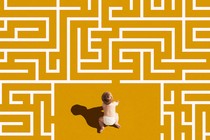Rachel Kushner’s Surprising Swerve
10 min read
“Sometimes I am boggled by the gallery of souls I’ve known. By the lore. The wild history, unsung,” Rachel Kushner writes in The Hard Crowd, her 2021 essay collection. “People crowd in and talk to me in dreams. People who died or disappeared or whose connection to my own life makes no logical sense, but exists as strong as ever, in a past that seeps and stains instead of fades.” As a girl in San Francisco’s Sunset District, Kushner ran with a group whom she has described as “ratty delinquents”—kids who fought, who set fires, who got high too young and too often, who in some cases wound up incarcerated or addicted or dead. At 16, she headed to UC Berkeley for college, but returned to the city after graduating, working at bars and immersing herself in the motorcycle scene. Almost immersing herself, anyway. Even when she was a 14-year-old sampling strangers’ drugs at rock concerts, some piece of Kushner was an observer as well as a participant, a student of unsung histories.
In her fiction, Kushner gravitates toward main characters who occupy that same split psychological place. All of her novels—her latest, Creation Lake, is her fourth—feature a young woman, usually a narrator, who shares her way of viewing the world. Kushner often loans her protagonists her own biker swagger, the hard layer of confidence that helps a woman survive in a very male environment. Preferring to write in the first person, she also gives her central characters her distinctive style: Kushner is alternately warm and caustic, funny and slippery, able to swing from high-literary registers to street slang and back in an instant. Her recurring theme has been the limits that even groups of outsiders impose on women, and yet her female characters, no matter how constrained they find themselves, are roving, curious thinkers, using their keen powers of observation to escape subjugation and victimhood—in their minds, if not in their circumstances.
With every book, Kushner has grown more interested in the push-pull between material restriction and psychic freedom. She’s especially intrigued by the effect that gender roles have on her characters’ strategies for navigating that tension. In each of her novels, a woman tries to both resist and exploit conventional ideas about female behavior. One of the main characters in Telex From Cuba, her 2008 debut, is a burlesque dancer named Rachel K (her name is taken from a real historical figure, though of course Kushner is winking in the mirror), whose very literal performance of femininity attracts some of the most powerful men in prerevolutionary Cuba. Her evident goal is to use these men to her own ends, but she winds up getting conscripted into their service instead.
Such failures of self-liberation continue through Kushner’s next novel, 2013’s The Flamethrowers, which was a breakout for her. Its protagonist, Reno, is a biker and an emerging artist who covets the independence and aura of influence that seem to come so easily to the men in both the art world and the 1970s Italian radical underground, of which she briefly becomes a part. Unlike Rachel K, Reno’s not a seductress. She’s not interested in seducing the reader, either. What Reno offers in place of charm is commentary so wryly smart and dispassionate that, especially in contrast with the male blowhards she repeatedly encounters, she seems powerful. But over the course of the novel, Kushner builds a skidding sense of perilousness, a feeling that no one, Reno included, is in charge or exempt from the mounting chaos. In the end, as Reno and the reader may have sensed all along, her detachment is just another performance, a cool-girl put-on not so different from Rachel K’s burlesque.
The irony that the aloof-observer stance turns into yet another trap is not lost on either Kushner or her narrators. Romy, the protagonist of The Mars Room (2018), takes especially bleak stock of her plight, and for good reason. She’s serving two life sentences after killing a stalker who latched on to her at the Market Street strip club where she worked and began menacing her and her child in their private life. For Romy, her flat narration (counterposed with excerpts from the Unabomber’s diary and chapters voiced by a sex-obsessed crooked cop) is a way of walling herself off, creating the mental freedom to imagine escape. Whether flight is a real act of hope, though, remains deliberately ambiguous. It may be an attempt at suicide.
Again and again, Kushner scrambles conventional ideas about gender, skewering male bravado while also subverting familiar ideas of femininity. Who and what counts as weak, she wants to know, and why? Stubborn stereotype portrays women as prey to emotion, unable to rein themselves in, yet in book after book, her protagonists’ relentless restraint has stood in stark contrast to the egotistical, violent impulsiveness of the men around them. In Creation Lake, Kushner complicates this dynamic. Her protagonist, Sadie Smith, is another dispassionate observer, but one who appears to have far more independence and agency than her predecessors. She’s a lone wolf, a private intelligence agent who has shucked off her home, her past, and even her name: “Sadie Smith” is an alias.
At the novel’s start, she’s en route to the Guyenne, a rural region in southwestern France, where she’s been hired to spy on Pascal Balmy, the leader of Le Moulin, a group of environmental radicals intent on sabotaging Big Agriculture. She has no idea who’s paying her or what their larger agenda might be, and yet she’s convinced that she’s playing her assigned part to perfection. Indeed, she has such faith in her toughness, acuity, and ability to dupe men that she considers herself all but invincible. Her vigilant predecessors Romy and Reno were much warier and wiser than Sadie, who loves bragging that any innocence she displays is just a pose.
Creation Lake is not a conventional spy novel, but, unlike Kushner’s shaggy earlier books, it often feels as tight as a thriller. Sadie’s “secret bosses” have sent her to the Guyenne not just to embed herself in Pascal’s group, but to undermine it. Gradually, readers understand that her assignment has a deadlier side—a realization that Sadie either suppresses or notices less quickly than she should, perhaps the most glaring giveaway that she’s not quite the clever spy she thinks. She’s sloppy, distractible, as drunk on her perception of her own power as any engine-revving “king of the road,” to use her derisive phrase for the swellheaded bikers among whom she first went undercover.
Sadie is also more impressionable—and less happy—than she’s ready to admit, which generates psychological ferment beneath the surface espionage plot. Creation Lake gets some of its suspense from its action, but Kushner mainly builds tension inside her narrator’s head. Sadie spends much of the novel reading Pascal’s correspondence with Bruno Lacombe, an aging philosopher whose opposition to modern civilization inspired Le Moulin at its founding. Living in a cave now, he reveres the collaborative and artistic Neanderthals, “who huddled modestly and dreamed expansively.” Initially, she dismisses Bruno’s ideas as crackpot, but they come to preoccupy her. For years, she’s told herself that she was content to carry out small parts of big, murky plans, duly suppressing her curiosity. Bruno’s emails urge her to take a broader, more inquisitive view: of humanity, of history, of alternative ways she could live. But once Sadie starts asking questions, things inside her start falling apart.
Not least, she starts questioning masculinity—or, rather, her ideas about it, which have dictated her espionage strategies and what she considers her success in the field. In the presence of others, Sadie the operative plays up her feminine sexual allure and compliance, but Sadie the narrator treats readers to a distinctly macho version of swagger. More than once, she notes that her breast augmentation is a calculated professional asset; she seems convinced that the same is true of her rootlessness and emotional disengagement. A hard drinker and frat-boy-style slob, she often seems to be trying to outman the men around her in her own mind, even as she must submit to them in reality.
Perhaps Sadie’s most traditionally masculine quality is her terror of weakness. But over the course of Creation Lake, as Sadie’s mission within Le Moulin gets riskier, she sees that her constant projection of control is alienating her from her desires, hollowing out her vaunted autonomy, making her easy to manipulate. She’s shattered—doubly so, because falling apart emotionally shocks her. It’s a fate Kushner withheld from her previous, more guarded protagonists. By letting tough-guy Sadie break down, she writes a radical conversion that is also a bold authorial leap: Kushner lets herself ask, for the first time in her career, what happens to a woman unmoored by masculine and feminine categorizing.
Putting Sadie under such intense pressure changes Creation Lake’s nature as a story. Once Sadie starts cracking, the novel doesn’t become digressive and loose like its predecessors, but it certainly stops feeling like a thriller. After many chapters that seemed to build to a dramatic act of sabotage, the story shifts register, heading into a very different, more emotional denouement. Relinquishing some swagger, Kushner opens up in her writing to new levels of feeling and possibilities for change.
In the process, she shakes up gender stereotypes in new ways. Creation Lake asks what sources of strength might be found in the kind of vulnerability, physical and emotional, that is associated with femininity. Sadie has prided herself on her supremely instrumental view of sex; she’d never get hysterical, never get too attached or lose her reason over a man. Although the strategic romance she’s begun with Lucien, a friend of Pascal’s, physically disgusts her, she boasts about not letting that get in her way. Kushner leans into the irony here: The reader sees well before Sadie does that her employers are exploiting precisely this blind willingness to obey them at real emotional cost to herself.
For all that she wants to treat her body as a professional resource, she can’t do it. Kushner’s exploration of sex as a catalyst for Sadie’s emotions breaking free is fascinating. Repelled by Lucien, she risks her job by beginning an affair with a partnered member of Le Moulin that starts out enjoyable but leaves her feeling abject; in its aftermath, Sadie begins nursing bigger doubts about her life. This drama could seem retrograde, but coming from Kushner, a restored connection between female body and mind feels less traditional than transformative.
Sex isn’t Sadie’s only route to a softer self. She also follows a more intellectual path to which she is led by Bruno, the cave-dwelling philosopher. Although Bruno has retreated from contemporary society, his reflections are what get Sadie to reconsider her pride in her nomadic self-sufficiency. She has long bridled at the notion that women should do—and enjoy—domestic work, and is emphatic that she will never have a baby. But she’s swayed by Bruno’s devotion to the painted caves and their former inhabitants, and by her own images of Bruno as a father, after she learns that he has grown children. Indeed, she develops a sort of daughterly love for Bruno.
By the end of the novel, his meditations bring out the feelings that she has most wanted to suppress: homesickness, nostalgia, loneliness. After reading an email in which Bruno describes his sense of being existentially lost, she says aloud, “I feel that way too.” The sound of her voice “let something into the room,” Sadie goes on, “some kind of feeling. The feeling was mine, even as I observed it, watched myself as if from above.” What Sadie sees is herself crying alone in bed, an image more suited to a teen movie than a Kushner novel. Yet this moment is no performance. In the grip of uncontrollable emotion, Sadie recognizes both her vulnerability and her desire to drastically change her life.
For Kushner, too, lowering the barricades against the clichés of femininity has an effect at once jarring and liberating. Her earlier novels veer away from culminating clarity, their explosive yet enigmatic endings reminding readers that her characters are too trapped and disempowered to change in the ways they want to. In Creation Lake, Sadie’s transfigured consciousness is a kind of resolution that might be mistaken for a sentimental promise of sunniness ahead—except that Kushner gives her narrator a new, daunting challenge. At the novel’s close, Sadie has already started experimenting with a life in which she engages fully rather than contorting herself to perform roles that others expect. She’s now armed with an agenda of her own, one that promises to turn her into a woman who couldn’t care less about what anyone thinks woman means. Creation Lake’s radicals aren’t likely to upend society, but Sadie’s swerve suggests that Kushner is ready for big change.
This article appears in the October 2024 print edition with the headline “Rachel Kushner’s Surprising Swerve.”

When you buy a book using a link on this page, we receive a commission. Thank you for supportingThe Atlantic.



